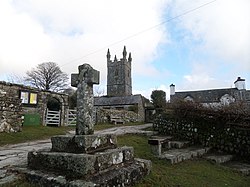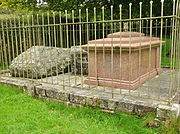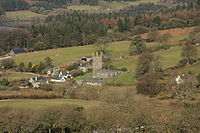Sheepstor
| Sheepstor | |
| Devon | |
|---|---|
 Sheepstor | |
| Location | |
| Grid reference: | SX560676 |
| Location: | 50°29’27"N, 4°1’55"W |
| Data | |
| Population: | 53 (2001) |
| Post town: | Yelverton |
| Postcode: | PL20 |
| Dialling code: | 01822 |
| Local Government | |
| Council: | West Devon |
| Parliamentary constituency: |
South West Devon |
| Website: | Sheepstor community |
Sheepstor is a small village in a fold in the hills on the western side of Dartmoor in Devon. Tiny as this place is, it has a fame on the other side of the world as the resting place of oriental princes.
The 2001 census recorded the parish population as 53, down from 95 in 1901.[1]
Burrator Reservoir, constructed in 1898, is to the north of the village and forms part of the northern boundary of the parish.[1]
Contents
Name
The name Sheepstor has evolved considerably since the first reference to a settlement here which was recorded in a pipe roll of 1168 as Sitelestorra. In a document of 1262 it was Skytelestor, Shittestorre in 1474, Shistor in 1547 and in c. 1620 Tristram Risdon called it Shetelstor now Shepstor.[2] The name is derived from that of the hill on whose slopes the villages stands, Sheeps Tor. Its name probably derives from the Old English scyttel(s) meaning a bar or bolt, reflecting the shape of the hill.[2]
The Rajahs of Sarawak
In the churchyard lies a massive, porphyry marble tomb, and beside it other more modest but of befitting grandeur, for in this sepulchre, beneath the cold rain of Devon, lies James Brooke Rajah of Sarawak, and around him his successors and the princely family. Brooke was born in India but of a Devon family. After a life of military adventure in the service of the service of the East India Company he bought a yacht, armed it, and sailed to Borneo, where he battled pirates and headhunters in the service of the Sultan. His reward for clearing the seas of pirates was his own kingdom, Sarawak, which with forthright energy he transformed into an effective, modern state. He had no children of his own, and in time retired from the jungles of Borneo to Sheepstor, leaving his nephew and heir to manage the state. Three White Rajahs ruled Sarawak before the destruction of the Japanese occupation and the threatening winds of nationalism drove the last to cede it to the British Empire.
Buried in the churchyard are the three Rajahs, James Brooke, Charles Brooke and Charles Vyner Brooke, as well as Bertram Willes Dayrell Brooke, the last heir, and member of the family. The graves of the Rajahs have been designated Grade II listed monuments by English Heritage.[3]
The church contains memorials to the princely family and gifts from the people of Sarawak.
Parish Church
The village church, dedicated to St Leonard, is built of granite and dates from the 15th century,[1] though a chapelry was first documented here in 1240.[4] The church contains a fine rood screen which was reconstructed in 1914 by the then vicar Hugh Breton from drawings made of the original that had been removed in a Victorian restoration.[1]
There are currently six bells in the church tower, five of which were cast in 1769, with a sixth hung in 1904; one of the older bells has inscribed on it the words 'I call the quick to church and the dead to grave'.[4] A local legend tells that the bell ropes of the church were once tied together and lowered into Crazywell Pool, two miles to the north east of Sheepstor, in order to determine the depth. According to the legend the ropes descended as much as 90 fathoms without reaching the bottom,[5] causing people to believe the pool is bottomless.
The church has been renovated several times, the most thorough of which was in 1861 at a cost of £590.[4]
Sheeps Tor
Sheeps Tor, from which the village is named, is a prominent outcrop about half a mile north east of the village. The summit is 1,211 feet above sea level and it is one of the area's most prominent tors.
Manor
The manor of Sheepstor was held by the Scudamore family, whose heirs were the Elford family.[6][7]
About the village
Nearby archaeological sites include:
Sheepstor on film
In 2010 Sheepstor was one of the filming locations for the Steven Spielberg film War Horse, and the village with its prominent church tower features in an aerial shot in the trailer for the film which was released in 2011.[8][9]
Outside links
| ("Wikimedia Commons" has material about Sheepstor) |
References
- ↑ 1.0 1.1 1.2 1.3 Harris, Helen (2004). A Handbook of Devon Parishes. Tiverton: Halsgrove. p. 148. ISBN 1-84114-314-6.
- ↑ 2.0 2.1 Gover, J. E. B. & Mawer, A. & Stenton, F.M.: 'Place-Names of Devon , Part 1' (English Place-Names Society, 1931), page 238–239
- ↑ National Heritage List 1326418: Garves of the Rajahs
- ↑ 4.0 4.1 4.2 Sandles, Tim. "Sheepstor Church". Legendary Dartmoor. http://www.legendarydartmoor.co.uk/sheepstor_church.htm. Retrieved 30 June 2010.
- ↑ Sandles, Tim. "Crazywell Pool". Legendary Dartmoor. http://www.legendarydartmoor.co.uk/crazy_well.htm. Retrieved 30 June 2010.
- ↑ Pole, Sir William (d.1635), Collections Towards a Description of the County of Devon (1792 edition) p 338
- ↑ Risdon, Tristram: 'A Survey of Devon' (1632), 1810 edition, p 195
- ↑ War Horse
- ↑ 'War Horse trailer: is Spielberg's thoroughbred on track for an Oscar?' – Ben Child in The Guardian, 29 June 2010
- Knights, Richard. "Sheeps Tor". Dartmoor Walks. http://www.richkni.co.uk/dartmoor/sheeps.htm. Retrieved 30 June 2010.

